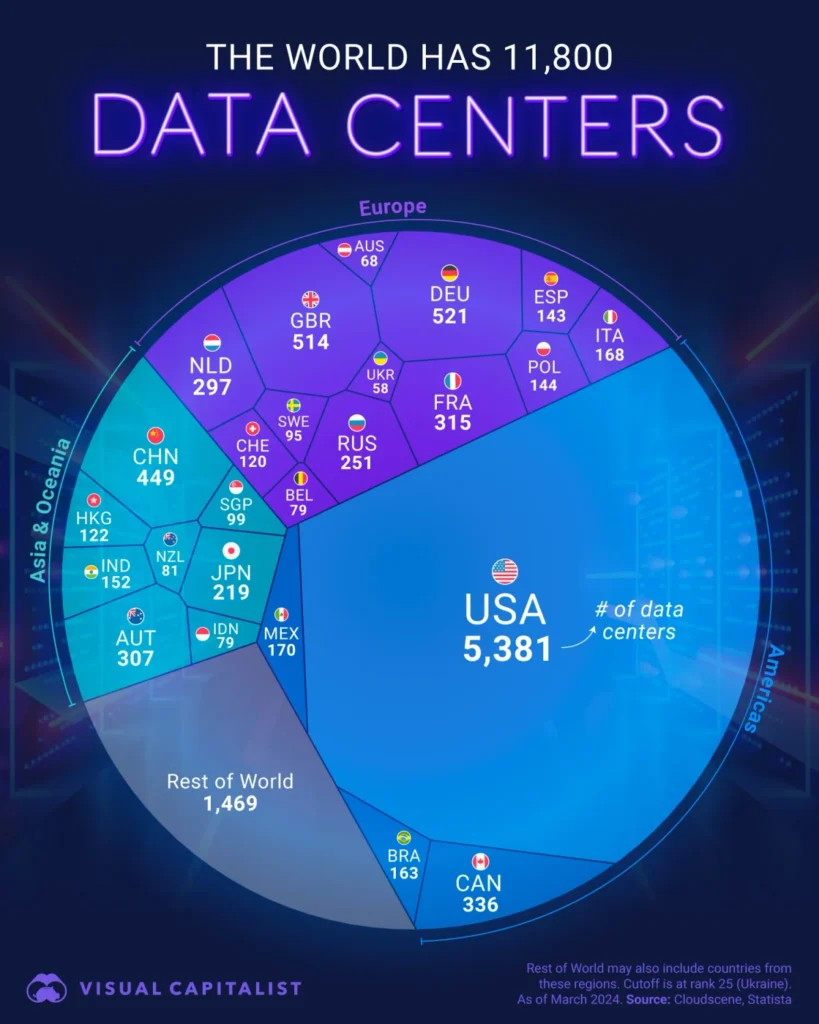Top 25 countries with the most data centres

US is the undisputed leader
In the digital age, data centres are the backbone of the internet. They house the infrastructure that powers everything from social media platforms to cloud computing services. As of March 2024, there were 11,800 data centres globally.
These facilities are essential for processing and storing vast amounts of data, and their numbers vary significantly across countries. Some nations lead the pack in terms of infrastructure.
The United States is the undisputed leader, home to more than 5,300 data centres, making up 45.6% of the global total. This dominance is primarily attributed to the immense investments made by tech giants like Microsoft, Amazon, and Google, which have poured billions into developing digital infrastructure to support the growing demand for data processing, cloud services, and artificial intelligence.
Following the US, Germany holds the second spot with 521 data centres, while the United Kingdom is third with 514. Both countries are well-established hubs for cloud computing and digital services in Europe. Germany’s strong data centre presence is driven by its robust tech ecosystem and central location within Europe, making it an attractive base for international firms seeking to meet European data protection regulations. Similarly, the UK’s data centres are integral to its economy, supporting finance and media industries.
Rounding out the top five is China, which boasts 449 data centres. Despite facing challenges in accessing the latest semiconductor technologies from the US due to ongoing trade tensions, China continues to expand its data centre infrastructure, developing its chips and technologies to support its growing digital economy. However, the country’s ambition to lead in this area is tempered by its struggle to compete with the West in cutting-edge chip manufacturing.

Canada, with 336 data centres, and France, with 315, complete the top five, reflecting both nations’ importance in the global digital economy. Canada’s development of data centres has been fuelled by its proximity to the U.S. and its favourable energy costs. At the same time, France benefits from its central role within the European Union and its position as a key player in the tech sector.
Australia, the Netherlands, Russia, Japan, and Mexico are the top ten countries with the most data centres. Australia’s 307 data centres reflect the country’s growing demand for cloud services. The Netherlands’ 297 data centres testify to its status as a critical hub for international data traffic, particularly in Europe.
Japan’s 219 data centres showcase its high-tech industry and investment in digital infrastructure. In comparison, Russia’s 251 data centres represent the country’s strategic interest in expanding its digital footprint despite challenges posed by sanctions and a complex regulatory environment.
The importance of data centres is only set to grow in the coming years. In fact, according to Goldman Sachs Research, data centres will be the largest driver of future electricity demand in the US. By 2030, data centres are expected to account for 8% of total electricity demand, up from just 3% in 2022. This shift is primarily driven by the energy-intensive nature of emerging technologies like artificial intelligence, with each ChatGPT query consuming significantly more electricity than a traditional Google search.
Despite this, expanding data centres present a unique challenge to many countries, particularly regarding energy consumption and the environmental impact of operating these massive facilities. As the global demand for data and digital services continues to rise, balancing technological growth with sustainability remains a key concern for governments and companies.
China’s continued growth in data centres has been hindered by the ongoing trade war with the U.S. and the difficulty of manufacturing advanced semiconductors. The country now faces developing its chip manufacturing capabilities, a challenging endeavour that requires years of research and expertise.
Moreover, due to restrictions on importing critical equipment from companies like the Netherlands’ ASML, China faces additional hurdles in advancing its tech infrastructure.
The global data centre landscape reflects the ever-expanding digital economy, with countries vying for dominance in an increasingly data-driven world. As we move forward, the race to build more data centres will likely continue to be a key area of focus for governments, businesses, and tech firms.
The top 25 countries with the most data centres
United States – 5,381
Germany – 521
United Kingdom – 514
China – 449
Canada – 336
France – 315
Australia – 307
Netherlands – 297
Russia – 251
Japan – 219
Mexico – 170
Italy – 168
Brazil – 163
India – 152
Poland – 144
Spain – 143
Hong Kong – 122
Switzerland – 120
Singapore – 99
Sweden – 95
New Zealand – 81
Indonesia – 79
Belgium – 79
Austria – 68
Ukraine – 58
The rest of the world accounts for 1,469 data centres globally.
Image: The United States is the undisputed leader, home to over 5,300 data centres. Credit: Christina Morillo













